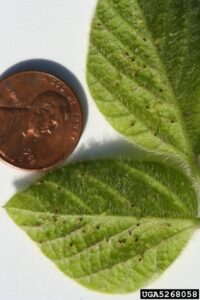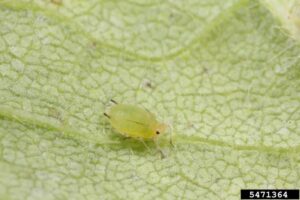Have you Forgotten About Soybean Aphids? – They’re Back!

Credit – Christina DiFonzo, Michigan State University, Bugwood.org
Soybean aphids have not been a concern since the early mid-2000s. These small, pear-shaped insects can be a major threat and cause damage to soybean plants. These pests suck sap from the soybean leaves which can lead to reduced yields if left uncontrolled. Further reduction of soybean yield can result from the dark, sooty mold that grows on the sugar excretions of heavy infestations of soybean aphids.
Soybean aphids overwinter as eggs on buckthorn in wooded areas. In the spring, the eggs hatch and several generations of aphids can result without mating. In time, winged aphids fly to soybeans where many more generations of both winged and wingless aphids are produced without mating during the summer. Their development is favored in late June and early July with temperatures of 72F -77F and relative humidity below 78%. Heat or temperatures above 95F could hinder their development.
Multiple strategies are recommended to effectively manage soybean aphids, while minimizing environmental impact and they are as follows:
Monitoring
All soybean fields are not created equal when it comes to an aphid problem because geography, landscape, biological, and agronomic factors can all influence soybean aphid populations. Scout fields regularly as aphid populations can rapidly increase, especially with winged aphids migrating into fields.
Scout early planted, smaller fields with wooded borders containing buckthorn. Later, scout all fields every 7 to 10 days. Earlier in the season, soybean aphids are more likely to be feeding on new growth and later in the season, they can be found throughout the soybean canopy.
- Check 20 to 30 plants per field.
- Don’t count dead aphids.
- Scout until R6.5 (pods and leaves begin to yellow)

Credit – Adam Sisson, Iowa State University, Bugwood.org
Treatment
Regularly scout soybean fields to detect aphid populations and determine if they have reached economically damaging levels. The economic threshold varies depending on factors such as soybean growth stage, number of aphids per plant, and the presence of natural enemies.
If all three conditions below are occurring from vegetative until R5, then you should consider treating your soybeans:
- Average of 250 (living) aphids per plant.
- More than 80 percent of the plants have aphids.
- Aphid populations are increasing.
This is the trigger point where you start to line up a labeled rate of foliar insecticide to prevent infestation from increasing to levels that will cause economically significant yield loss. As you consider management options, keep in mind that many soybean aphid populations could be resistant to pyrethroid (group 3A) insecticides.

Caption: Jim Doolittle. Precision Agronomist in Southern Wisconsin/Northern Illinois has been finding aphids in Northern Illinois and has made the decision to treat some fields.
Natural enemies:
Beneficial insects, such as ladybugs, lacewings, and parasitic wasps, can help control soybean aphid populations. Preserving natural enemy populations by minimizing broad-spectrum insecticide use and not treating aphids too early is an important part of Integrated Pest Management (IPM).
Resistant varieties:
Planting soybean varieties that have genetic resistance to soybean aphids can help reduce the need for insecticide applications, but their availability may be limited.
Cultural practices:
Implementing practices like planting dates, row spacing, and fertility management can help optimize plant health and potentially reduce aphid populations.
Sources:
Soybean aphids beginning to colonize soybean fields (umn.edu)


 and then
and then